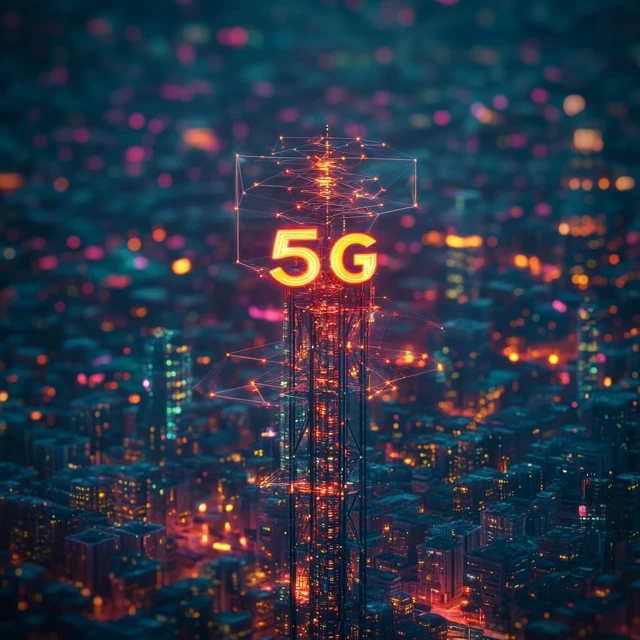Introduction: Beyond Speed
When we talk about 5G, most people think of blazing-fast downloads and buffer-free streaming.
But 5G isn't just about higher bandwidth—it's also a fundamental shift in how devices connect,
offering ultra-low latency, improved reliability, and the capacity to support massive numbers
of IoT devices. These changes open doors for new immersive experiences, from cloud gaming to
autonomous vehicles, making 5G a transformative force in tech.
In this guide, we'll break down what 5G actually is, how it compares to previous mobile network
generations, and the real-world applications that could revolutionize everyday life. Whether
you're curious about your next smartphone upgrade or the future of smart cities, here's the
inside scoop on 5G's potential.
1. What Is 5G & How It Works
5G stands for “fifth generation” mobile network technology, succeeding 4G LTE.
It uses new radio frequencies, along with advanced infrastructure, to boost speed,
reduce latency, and handle more connected devices at once:
- Millimeter Wave (mmWave): Extremely high frequencies deliver very fast
data rates but have limited range, making them best for dense urban or indoor areas.
- Mid-Band & Low-Band: Lower frequencies have broader coverage,
but slightly slower speeds than mmWave. These bands fill in coverage gaps and
ensure wide-scale availability.
- Massive MIMO & Beamforming: Multiple-input multiple-output
antennas and smart signal targeting (beamforming) help direct signals precisely
where needed, enhancing performance and reducing interference.
- Network Slicing: 5G networks can “slice” bandwidth for specific use cases.
A self-driving car might get a low-latency slice, while streaming apps get high data throughput,
optimizing resources dynamically.
These innovations combine to create networks that can deliver gigabit speeds and
near-instant responsiveness, enabling experiences once considered sci-fi.
2. Comparing 5G with 4G & Earlier Generations
Each mobile generation introduced leaps in speed and capabilities. Here's how 5G stands out:
- 3G: First widely used for data, enabling basic mobile web &
slow app usage. Speeds reached a few Mbps (megabits per second) in ideal conditions.
- 4G LTE: Revolutionized streaming and real-time apps with tens
of Mbps, sometimes hitting 100+ Mbps, but real speeds varied by coverage.
- 5G Peak Rates: Potentially in the multi-gigabit range (1-10 Gbps).
Real-world speeds average hundreds of Mbps, still significantly outpacing 4G's best
typical results.
- Latency Reduction: 4G typically had ~30-50 ms latency. 5G aims
for sub-10 ms, crucial for gaming, VR, or remote surgery scenarios.
While 4G was a game-changer for mobile data, 5G's advanced features target far
broader use cases—especially those demanding real-time responsiveness and massive
connectivity.
3. Key Benefits: Speed, Latency & Massive Capacity
So how does 5G's core advantages translate into everyday perks?
- Faster Downloads & Streaming: Ultra HD video or large game files
can download in seconds rather than minutes, ensuring buffer-free streaming
at 4K or beyond.
- Reduced Lag for Gaming & VR: Competitive online games rely on
rapid input feedback. With sub-20 ms latency, gamers can enjoy near-instant responses,
and VR experiences feel more seamless.
- Support for IoT Devices: Smart homes, wearables, connected cars—5G's
capacity to handle a high density of devices simultaneously fosters new IoT ecosystems
without network congestion.
- Cloud-Driven Apps: High-speed, low-latency connections let apps offload
processing to the cloud. This could power advanced AI or high-end graphics on minimal hardware,
all streaming back to your device in real time.
The net result: a more responsive, data-rich environment that enhances daily digital life
and unlocks next-level applications.
4. Use Cases: From Entertainment to Industry
5G's capabilities ripple beyond smartphone speeds, impacting everything from
home streaming to large-scale industrial operations:
- HD & 4K Streaming: Platforms like Netflix, YouTube, or
interactive livestreams can deliver crisp visuals with no buffering,
even for multiple users in one household.
- Cloud Gaming Platforms: Services like NVIDIA GeForce Now or
Microsoft xCloud rely on stable, high-bandwidth connections. 5G ensures minimal
input lag, letting you stream top-tier games on handheld devices or TVs seamlessly.
- Smart Cities & Logistics: Traffic lights, sensors, and
connected vehicles can coordinate in real time, reducing congestion. Factories
might run wireless robotics or AI-driven processes that require sub-second data exchange.
- Healthcare & Telemedicine: Remote surgery or high-quality
telehealth sessions benefit from stable high-speed connections, bridging distance
between specialists and patients with near-real-time responsiveness.
The synergy of speed and reliability fosters new innovations, from everyday convenience
to life-saving technology leaps.

5. Challenges & Rollout Factors
Despite the hype, 5G's global rollout faces hurdles that can affect availability
and performance:
- Infrastructure Costs: Deploying new base stations, especially
for mmWave with shorter range, is expensive. Telecoms must invest heavily
to expand coverage.
- Device Compatibility: Older phones can't access 5G. Users need
5G-ready devices, and even some new ones may only support specific frequency bands.
- Spectrum Availability: Government auctions and regulatory
approvals differ by country. Some markets get mid-band first; others focus
on mmWave or low-band.
- Line-of-Sight & Building Penetration: High frequencies
struggle to penetrate walls or travel far, requiring dense networks of small
cells for consistent coverage in urban environments.
Over the next few years, carriers will race to improve coverage,
bridging these challenges with denser networks and better technology integration.
5G: Pros & Cons at a Glance
| Pros |
Cons |
| Ultra-fast speeds, low latency |
Higher infrastructure costs |
| Supports dense IoT connectivity |
Limited range for mmWave signals |
| Enables advanced apps (cloud gaming, VR) |
Requires 5G-compatible devices |
| Potential for new business/industrial solutions |
Deployment varies widely by region |
While 5G's benefits can be transformative, its real impact depends on widespread
adoption, stable coverage, and consumer access to 5G-ready hardware.
Conclusion
5G is poised to reshape digital experiences—from speedier Netflix binges
to real-time collaborative gaming, advanced telemedicine, and connected
city infrastructure. Though coverage gaps and device requirements remain
hurdles, continued investment promises more uniform, robust networks in the
coming years.
For consumers, 5G means quicker downloads, immersive media, and the convenience
of truly on-the-go computing. For industries, it introduces unprecedented
connectivity for automation, AI-driven processes, and remote operations.
As 5G technology matures, watch for it to spark fresh innovations, bridging
physical and digital realms like never before.

